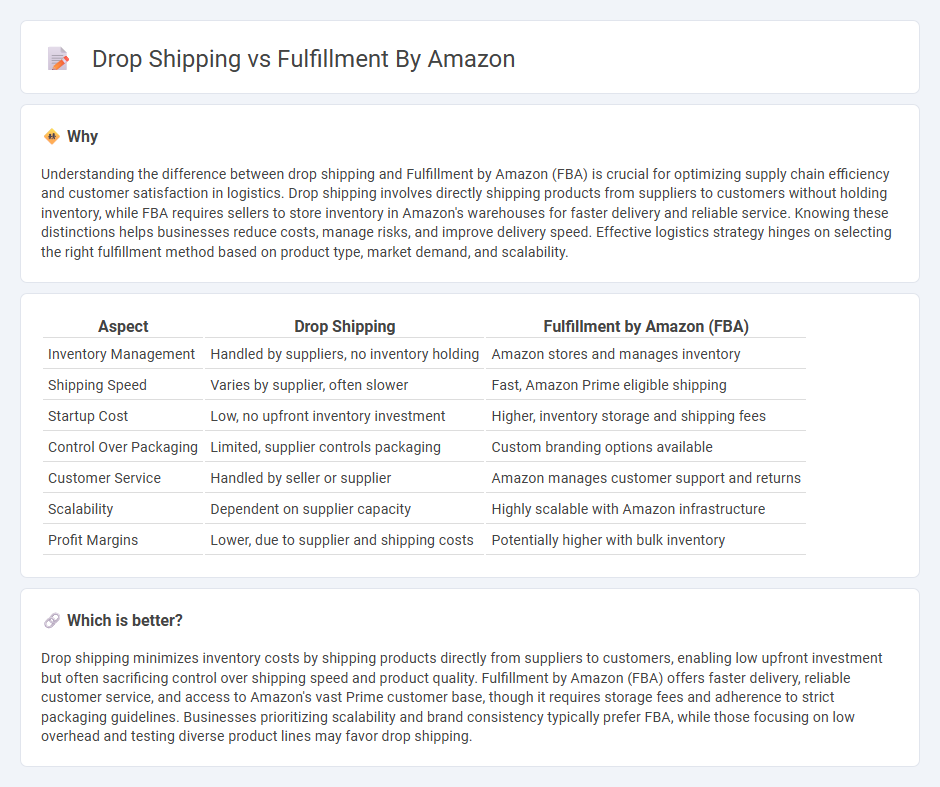
Drop shipping allows sellers to list products without holding inventory, relying on suppliers to ship directly to customers, which minimizes upfront costs and risk. Fulfillment by Amazon (FBA) involves storing products in Amazon's warehouses, where the company handles packaging, shipping, and customer service, enhancing delivery speed and reliability. Explore this guide to understand which logistics model fits your e-commerce strategy best.
Why it is important
Understanding the difference between drop shipping and Fulfillment by Amazon (FBA) is crucial for optimizing supply chain efficiency and customer satisfaction in logistics. Drop shipping involves directly shipping products from suppliers to customers without holding inventory, while FBA requires sellers to store inventory in Amazon's warehouses for faster delivery and reliable service. Knowing these distinctions helps businesses reduce costs, manage risks, and improve delivery speed. Effective logistics strategy hinges on selecting the right fulfillment method based on product type, market demand, and scalability.
Comparison Table
| Aspect | Drop Shipping | Fulfillment by Amazon (FBA) |
|---|---|---|
| Inventory Management | Handled by suppliers, no inventory holding | Amazon stores and manages inventory |
| Shipping Speed | Varies by supplier, often slower | Fast, Amazon Prime eligible shipping |
| Startup Cost | Low, no upfront inventory investment | Higher, inventory storage and shipping fees |
| Control Over Packaging | Limited, supplier controls packaging | Custom branding options available |
| Customer Service | Handled by seller or supplier | Amazon manages customer support and returns |
| Scalability | Dependent on supplier capacity | Highly scalable with Amazon infrastructure |
| Profit Margins | Lower, due to supplier and shipping costs | Potentially higher with bulk inventory |
Which is better?
Drop shipping minimizes inventory costs by shipping products directly from suppliers to customers, enabling low upfront investment but often sacrificing control over shipping speed and product quality. Fulfillment by Amazon (FBA) offers faster delivery, reliable customer service, and access to Amazon's vast Prime customer base, though it requires storage fees and adherence to strict packaging guidelines. Businesses prioritizing scalability and brand consistency typically prefer FBA, while those focusing on low overhead and testing diverse product lines may favor drop shipping.
Connection
Drop shipping and Fulfillment by Amazon (FBA) both streamline e-commerce logistics by handling inventory storage and order fulfillment, reducing the need for merchant-managed warehousing. Drop shipping allows sellers to list products without holding stock, while FBA enables sellers to store products in Amazon's warehouses for faster shipping and Prime eligibility. Combining these models can optimize supply chain efficiency, improve delivery speed, and enhance customer satisfaction in online retail.
Key Terms
Inventory Management
Fulfillment by Amazon (FBA) streamlines inventory management by storing products in Amazon's warehouses, handling packing, shipping, and customer service, which reduces seller burden and ensures faster delivery times. Drop shipping eliminates inventory holding entirely; sellers forward customer orders to suppliers who ship directly, minimizing upfront costs but increasing dependency on third-party stock accuracy and shipping speed. Explore further to understand which inventory management strategy aligns best with your e-commerce goals.
Order Processing
Fulfillment by Amazon (FBA) involves Amazon handling storage, packing, and shipping, ensuring faster delivery and reliable order processing through its extensive logistics network. Drop shipping relies on suppliers to directly ship products to customers, which can lead to variable processing times and less control over order fulfillment quality. Explore detailed comparisons to determine which model best fits your e-commerce logistics strategy.
Shipping Responsibility
Fulfillment by Amazon (FBA) shifts shipping responsibility to Amazon, ensuring fast, reliable delivery through their extensive logistics network, while drop shipping places the shipping burden on the supplier, often leading to variable delivery times and quality control challenges. FBA provides sellers with Amazon Prime eligibility, enhancing customer trust and boosting sales potential. Discover how shipping responsibilities impact your e-commerce success by exploring these models further.
Source and External Links
Amazon FBA vs FBM: Which is right for you? - Fulfillment by Amazon (FBA) allows sellers to send products into Amazon's fulfillment network, outsourcing packing, shipping, customer service, and returns to Amazon while enabling fast, free Prime shipping for customers.
Fulfillment by Amazon (FBA) - With FBA, sellers ship products to Amazon's global fulfillment centers, and Amazon handles picking, packing, shipping, customer service, and returns, offering benefits like discounted shipping, Prime eligibility, and access to a worldwide distribution network.
Amazon FBA for beginners - FBA streamlines ecommerce by storing sellers' inventory in Amazon's network, managing all fulfillment tasks, and providing access to additional services like Multi-Channel Fulfillment for orders outside Amazon.
 dowidth.com
dowidth.com